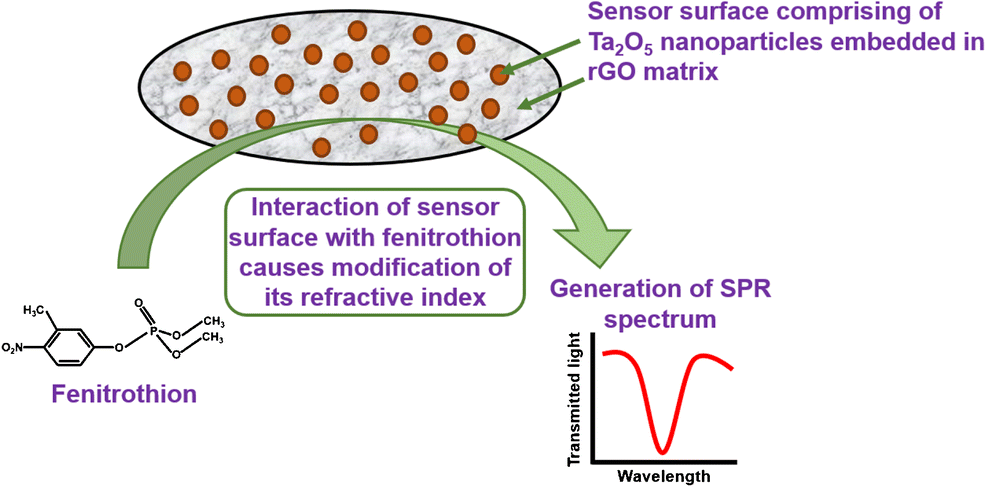当前位置:
X-MOL 学术
›
Microchim. Acta
›
论文详情
Our official English website, www.x-mol.net, welcomes your
feedback! (Note: you will need to create a separate account there.)
Surface plasmon resonance based fiber–optic nanosensor for the pesticide fenitrothion utilizing Ta2O5 nanostructures sequestered onto a reduced graphene oxide matrix
Microchimica Acta ( IF 5.3 ) Pub Date : 2019-12-03 , DOI: 10.1007/s00604-019-4002-8 Ravi Kant 1
Microchimica Acta ( IF 5.3 ) Pub Date : 2019-12-03 , DOI: 10.1007/s00604-019-4002-8 Ravi Kant 1
Affiliation

|
A surface plasmon resonance study was carried out for the identification and determination of the organophosphate pesticide fenitrothion via an optical fiber sensor. A thin layer of silver was deposited on the unclad core of silica optical fiber for plasmon generation. This was followed by the deposition of a sensing surface comprising a layer of tantalum(V) oxide nanoparticles sequestered in a nano–scaled matrix of reduced graphene oxide. The sensing mechanism is due to the interaction of fenitrothion with the silver film which leads to a change in refractive index.. Characterized by a wavelength interrogation scheme, the fiber–optic sensor exhibited a red shift equalling 56 nm corresponding to fenitrothion concentration in the range 0.25–4 μM including the blank solution. The spectral sensitivity is 24 nm μM−1, the limit of detection is 38 nM, and the response time is as short as 23 s. The sensor is selective, repeatable and works at ambient temperature. Graphical abstract Schematic representation of the sensing mechanism of an SPR based fiber–optic fenitrothion sensor utilizing modification in refractive index of sensing surface comprising of tantalum(V) oxide (Ta2O5) nanoparticles embedded in reduced graphene oxide (rGO) caused by interaction with fenitrothion entities. Schematic representation of the sensing mechanism of an SPR based fiber–optic fenitrothion sensor utilizing modification in refractive index of sensing surface comprising of tantalum(V) oxide (Ta2O5) nanoparticles embedded in reduced graphene oxide (rGO) caused by interaction with fenitrothion entities.
中文翻译:

基于表面等离子体共振的光纤纳米传感器,用于利用螯合在还原氧化石墨烯基质上的 Ta2O5 纳米结构的杀虫剂杀螟。
进行了表面等离子体共振研究,以通过光纤传感器鉴定和测定有机磷农药杀螟松。一层薄薄的银沉积在石英光纤的裸芯上,用于产生等离子体。随后沉积传感表面,该表面包含一层隔离在还原氧化石墨烯纳米级基质中的氧化钽 (V) 纳米颗粒。传感机制是由于杀螟硫磷与银膜的相互作用导致折射率发生变化。 以波长询问方案为特征,光纤传感器表现出等于 56 nm 的红移,对应于范围内的杀螟硫磷浓度0.25–4 μM,包括空白溶液。光谱灵敏度为 24 nm μM−1,检测限为 38 nM,响应时间短至23秒。该传感器具有选择性、可重复性并在环境温度下工作。图形摘要 基于 SPR 的光纤杀螟硫磷传感器的传感机制示意图,利用由与杀螟硫磷实体相互作用引起的嵌入还原氧化石墨烯 (rGO) 中的氧化钽 (V) (Ta2O5) 纳米颗粒组成的传感表面折射率的修改. 基于 SPR 的光纤杀螟硫磷传感器的传感机制示意图,该传感器利用由与杀螟硫磷实体相互作用引起的嵌入还原氧化石墨烯 (rGO) 中的氧化钽 (V) (Ta2O5) 纳米颗粒组成的传感表面折射率的改变。图形摘要 基于 SPR 的光纤杀螟硫磷传感器的传感机制示意图,利用由与杀螟硫磷实体相互作用引起的嵌入还原氧化石墨烯 (rGO) 中的氧化钽 (V) (Ta2O5) 纳米颗粒组成的传感表面折射率的改变. 基于 SPR 的光纤杀螟硫磷传感器的传感机制示意图,该传感器利用由与杀螟硫磷实体相互作用引起的嵌入还原氧化石墨烯 (rGO) 中的氧化钽 (V) (Ta2O5) 纳米颗粒组成的传感表面折射率的改变。图形摘要 基于 SPR 的光纤杀螟硫磷传感器的传感机制示意图,利用由与杀螟硫磷实体相互作用引起的嵌入还原氧化石墨烯 (rGO) 中的氧化钽 (V) (Ta2O5) 纳米颗粒组成的传感表面折射率的改变. 基于 SPR 的光纤杀螟硫磷传感器的传感机制示意图,该传感器利用由与杀螟硫磷实体相互作用引起的嵌入还原氧化石墨烯 (rGO) 中的氧化钽 (V) (Ta2O5) 纳米颗粒组成的传感表面折射率的改变。
更新日期:2019-12-03
中文翻译:

基于表面等离子体共振的光纤纳米传感器,用于利用螯合在还原氧化石墨烯基质上的 Ta2O5 纳米结构的杀虫剂杀螟。
进行了表面等离子体共振研究,以通过光纤传感器鉴定和测定有机磷农药杀螟松。一层薄薄的银沉积在石英光纤的裸芯上,用于产生等离子体。随后沉积传感表面,该表面包含一层隔离在还原氧化石墨烯纳米级基质中的氧化钽 (V) 纳米颗粒。传感机制是由于杀螟硫磷与银膜的相互作用导致折射率发生变化。 以波长询问方案为特征,光纤传感器表现出等于 56 nm 的红移,对应于范围内的杀螟硫磷浓度0.25–4 μM,包括空白溶液。光谱灵敏度为 24 nm μM−1,检测限为 38 nM,响应时间短至23秒。该传感器具有选择性、可重复性并在环境温度下工作。图形摘要 基于 SPR 的光纤杀螟硫磷传感器的传感机制示意图,利用由与杀螟硫磷实体相互作用引起的嵌入还原氧化石墨烯 (rGO) 中的氧化钽 (V) (Ta2O5) 纳米颗粒组成的传感表面折射率的修改. 基于 SPR 的光纤杀螟硫磷传感器的传感机制示意图,该传感器利用由与杀螟硫磷实体相互作用引起的嵌入还原氧化石墨烯 (rGO) 中的氧化钽 (V) (Ta2O5) 纳米颗粒组成的传感表面折射率的改变。图形摘要 基于 SPR 的光纤杀螟硫磷传感器的传感机制示意图,利用由与杀螟硫磷实体相互作用引起的嵌入还原氧化石墨烯 (rGO) 中的氧化钽 (V) (Ta2O5) 纳米颗粒组成的传感表面折射率的改变. 基于 SPR 的光纤杀螟硫磷传感器的传感机制示意图,该传感器利用由与杀螟硫磷实体相互作用引起的嵌入还原氧化石墨烯 (rGO) 中的氧化钽 (V) (Ta2O5) 纳米颗粒组成的传感表面折射率的改变。图形摘要 基于 SPR 的光纤杀螟硫磷传感器的传感机制示意图,利用由与杀螟硫磷实体相互作用引起的嵌入还原氧化石墨烯 (rGO) 中的氧化钽 (V) (Ta2O5) 纳米颗粒组成的传感表面折射率的改变. 基于 SPR 的光纤杀螟硫磷传感器的传感机制示意图,该传感器利用由与杀螟硫磷实体相互作用引起的嵌入还原氧化石墨烯 (rGO) 中的氧化钽 (V) (Ta2O5) 纳米颗粒组成的传感表面折射率的改变。































 京公网安备 11010802027423号
京公网安备 11010802027423号